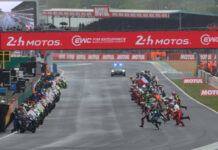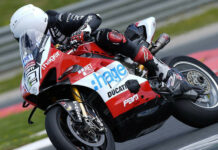No body armor, no leathers, no helmet. No need for any of those if crashes are eliminated. That is at the core of the concept vehicle and the vision for motorcycling’s future unveiled as part of BMW’s “Iconic Impulses” celebration of the company’s first century of operations and a look toward the next 100 years of mobility.
“The potential of connectivity and digitization enables our vision of the ultimate riding experience. In the future, riders will be able to take in the environment with all senses and a free mind,” Edgar Heinrich, head of design for BMW Motorrad, told members of the press gathered at a converted aircraft hangar at Santa Monica Airport. “Once you are on the motorcycle, it will give you absolute freedom.”
As part of the introduction, a rider clad in a concept riding suit of the future glided the BMW Motorrad VISION NEXT 100 motorcycle onto the rotating stage area, put her feet down, then lifted her feet and sat in the riding position as the two-wheeler balanced perfectly. After the stage had rotated, she silently rode off stage, the perfect introduction for Heinrich’s detailed explanation of the key ideas incorporated into the concept motorcycle.
Among those concepts:
– A flexible carbon fiber composite frame that twists to steer the motorcycle, eliminating conventional telescopic forks.
“To us, innovation can also mean reduction. The flex frame connects the front wheel and the rear wheel with a dynamic curve – it looks almost like it has been cultured. This organic flex type of construction allows us to introduce new steering movements that are very, very removed from today’s geometries,” Heinrich said. “As the headbox turns, the entire flex frame adapts to the shape to change direction. This requires forces that vary depending on the riding situation. Steering a stationary motorcycle is particularly easy, while it gets harder as the vehicle accelerates.
“We consider carbon fiber the material of the future. Embedded with other (components), this is a material still with very promising potential.”
– A moveable engine that shifts its position in the chassis as speeds increase to meet ergonomic and aerodynamic demands.
– A self-balancing system that can be programmed to activate at different lean angles and situations.
“It will (limit) the lean angle for beginners and therefore increase their confidence and their safety. The system will only be triggered when absolutely necessary,” Heinrich said. “(Expert riders) benefit from the same system, but in a very different way. For them, it will actively boost the motorcycle’s riding dynamics – and the fun, of course. Only the laws of physics will limit their performance. The system allows all riders to steadily improve their performance and gather an abundance of positive riding experiences, completely independent of their skills. The self-balancing system will lift their riding to a whole new level. It doesn’t tip over, even when it stands still. The sidestand is used only when the bike is shut down.”
– Electronic systems that will interact with the rider and with increasingly sophisticated road systems. The information will be displayed by projection onto a visor, which will double as the windshield. The heads-up display will be subtle and simplistic, whereas more sophisticated information such as detailed route conditions will be displayed on a digital tank bag screen. Traditional gauges will disappear.
– As more and more vehicles begin to interact with each other and with information provided by the actual highway, the potential for a crash is eliminated, said Stephan Schaller, head of BMW Motorrad, in a separate news conference after the official introduction. “The idea behind the whole concept is that you don’t have an impact. You avoid an impact by this connectivity and this technology which we think the future bike will incorporate.”
While it may be hard to grasp, the reality is that large automated vehicles already are operating on “smart” roads in places like shipping port terminals, and already feature the ability to sense problems ahead and adapt. Self-driving cars are no longer part of the future, but the present.
BMW officials simply combined the idea of vehicle-to-vehicle communication that prevents collisions to the idea of road-to-vehicle communication that conveys traction information and other obstacles to the motorcycle’s vehicle control and self-balancing systems. Between the two, the chances of a motorcyclist hitting anything goes away.
– That eliminates the need for protective gear and allows the riding suit of the future to provide comfort and feedback, Heinrich and Schaller said. The suit provides cooling and heating and illumination, and patches on the suit can vibrate to warn the rider that they are, for example, approaching a curve too quickly for surface conditions.
“We believe that future motorcycle riders will be able to enjoy their experience without protective gear. Instead, motorcycle gear of the future will be more of a fashion statement combined with outer functionality. These garments will provide riders with the ultimate sense of freedom of the thrilling days of motorcycle riding,” Heinrich says. “The rider’s gear will no longer have to focus on protection as there will be no protective padding and no need to wear a helmet.
“We would like to give our customers the same sense of freedom that riders experienced in the very earliest days of motorcycle riding – the wind in your hair, the sounds, all these indescribable feelings. It’s pure emotion. With our bike, the rider will be able to focus on this riding experience.”






